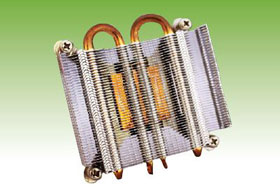Zipper fin heatsinks
20 May 2015
Circuit & System Protection

Benefitting from high performance and light weight, zipper fin heatsinks from Advanced Thermal Solutions can be used to cool LEDs, as well as hot components in telecom, datacom, military and embedded electronics.
Zipper fins are machined from thin sheet metal, typically aluminium or copper, and are formed into custom shapes. The sheets are designed to interlock with a very narrow space between their layers. The fin assembly is wave soldered to a metal base forming a very rigid, lightweight heatsink.
The production process yields a lower-cost heatsink than bonded fin designs, mainly because bonded heatsinks require more expensive tooling to manufacture. Zipper fin heatsinks can also be made in high aspect ratio fin profiles, enabling taller, thinner and more tightly packed fins for higher cooling performance.
Zipper fin sinks can be designed with integral ducts to contain and optimise cooling airflow. This improves thermal performance, particularly with active sinks that receive airflows from fans and blowers. For many of these designs, the top surface of the heatsink can also be used as a heat spreader for hot components.
Zipper fin heatsinks allow the combined use of copper and aluminium materials. In these designs, the copper base allows for optimal heat spreading while the aluminium fins ensure the heatsink will be lightweight.
For more information visit www.qats.com
Further reading:
Smarter protection without disruption
NewElec Pretoria
Circuit & System Protection
Designed for operations still running without integrated automation, NewElec’s retrofit-friendly systems let you upgrade performance and safety without overhauling your entire network.
Read more...
Circuit breaker for reliable, compliant protection
RS South Africa
Circuit & System Protection
Legrand’s low-voltage power distribution portfolio encompasses the DX3 range of miniature circuit breakers, designed to deliver dependable protection in residential, commercial and industrial installations.
Read more...
Reducing noise on power supply lines
Future Electronics
Circuit & System Protection
Murata has introduced the EMIFIL ESD Series Noise Filters, a breakthrough solution engineered for superior noise suppression and enhanced electrostatic discharge (ESD) protection.
Read more...
Clearing the Static: Fundamental principles of static control
Actum
Circuit & System Protection
Controlling electrostatic discharge in electronics manufacturing is essential with effective ESD programs built on six key principles.
Read more...
Electrical fire safety in lithium-ion battery rooms
Circuit & System Protection
Pratliperl is a non-combustible, ultra-lightweight aggregate that can be mixed with cement and applied as a plaster or screed to walls, floors, and ceilings.
Read more...
Clearing the Static: ESD training in the workplace
Actum
Circuit & System Protection
To protect sensitive electronic components, A structured, consistent, and sustainable ESD training program is essential.
Read more...
Protect your pumps – protect your profit
NewElec Pretoria
Circuit & System Protection
In South Africa’s demanding agricultural landscape, irrigation is not just an essential service – it is the heartbeat of farm productivity.
Read more...
Clearing the Static: ESD and installation: A durable antistatic solution
Actum
Circuit & System Protection
ESD flooring provides a reliable, long-term solution for managing static electricity by safely dissipating static charges through the floor to a designated ground point.
Read more...
Why wait to automate
NewElec Pretoria
Circuit & System Protection
NewElec’s initiative helps you gain operational visibility via HMI or PLC by retrofitting intelligent motor protection relays without replacing MCCs or rewiring the plant.
Read more...
Clearing the Static: Effectively control static in your workplace
Actum
Circuit & System Protection
Controlling electrostatic discharge in the workplace is crucial to protect sensitive electronic equipment from damage. Implementing an ESD control program involves various measures and tests.
Read more...


